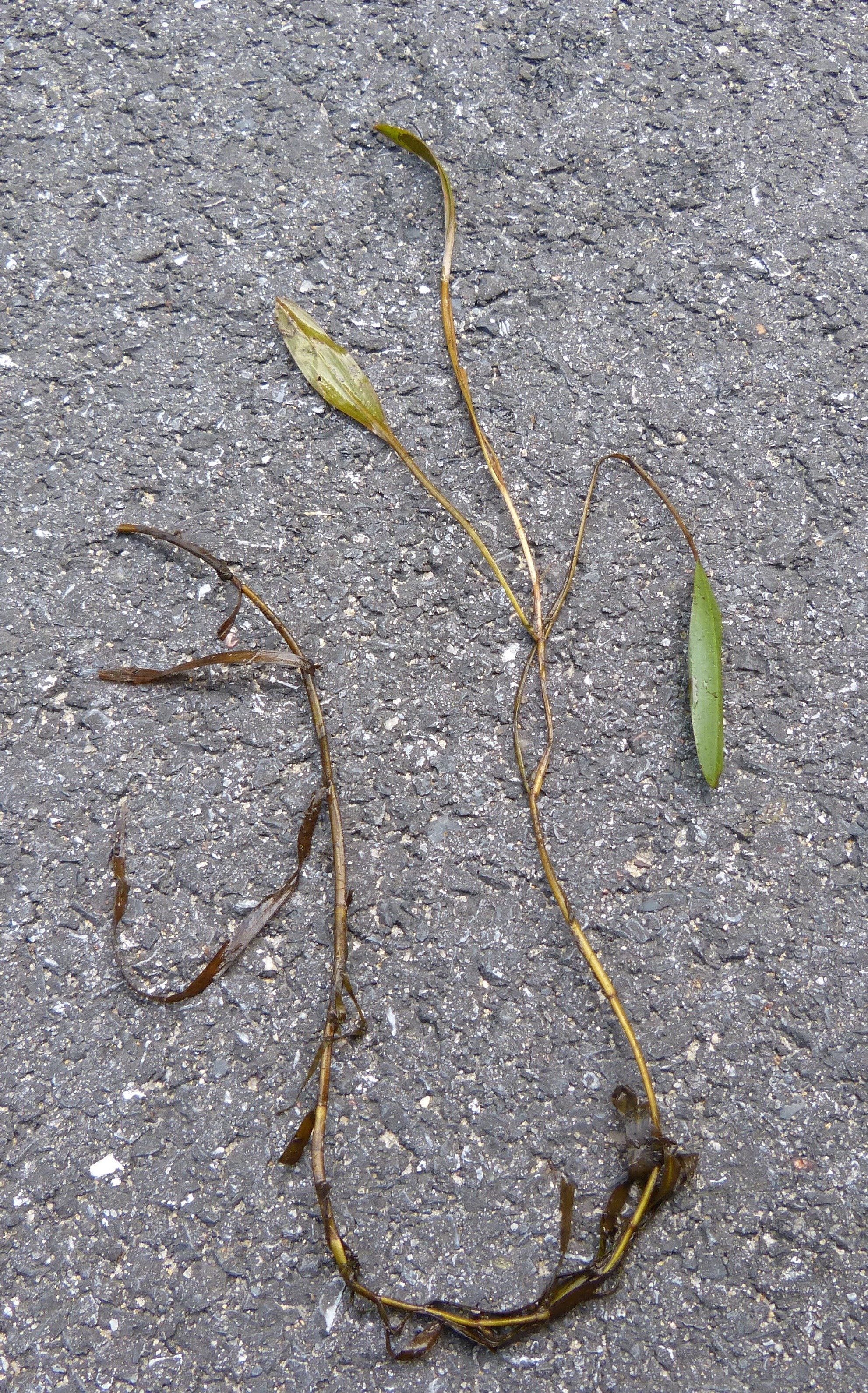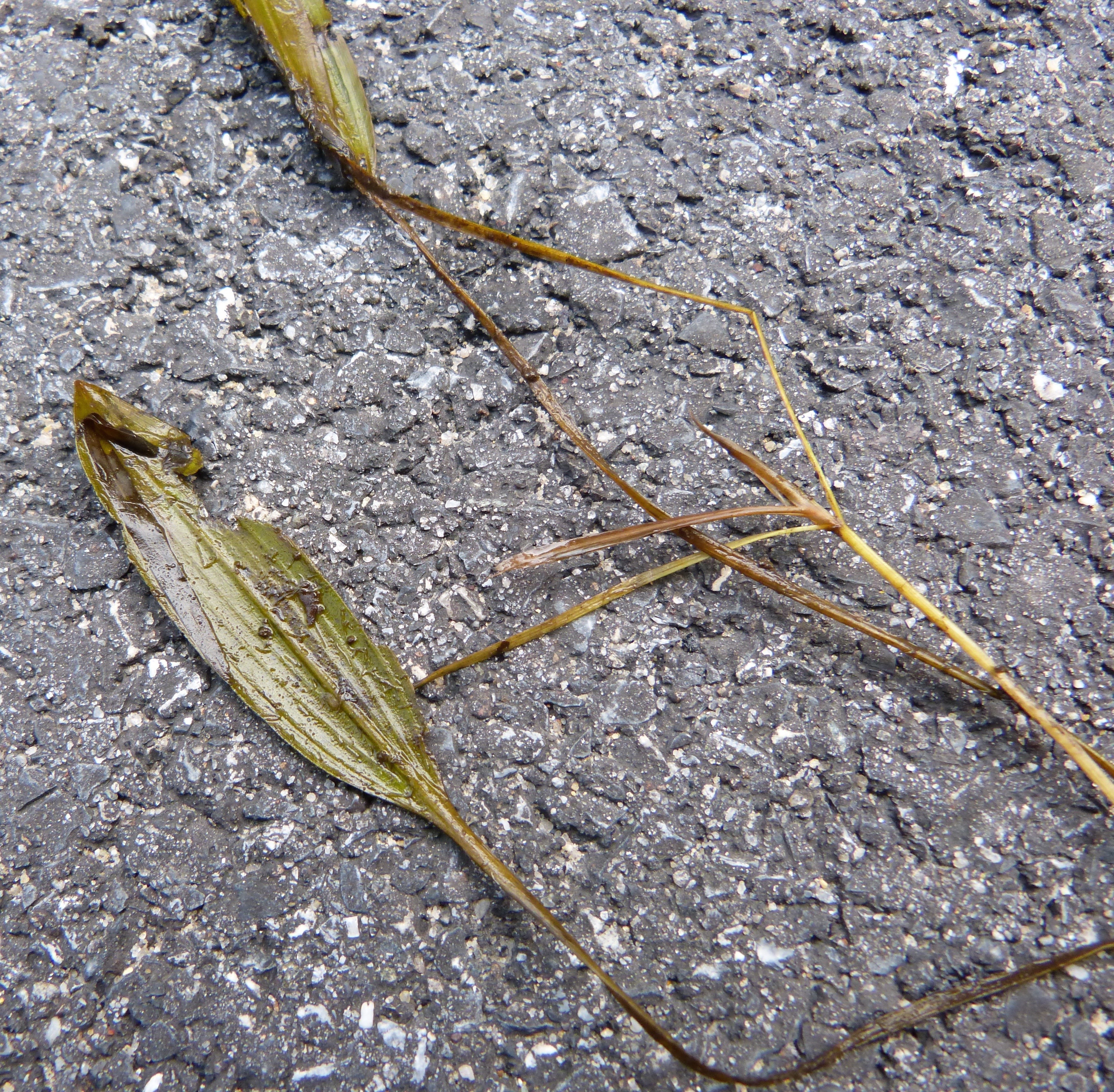Map Snapshot













34 Records
Seasonality Snapshot
Source: Wikipedia
| Potamogeton epihydrus | |
|---|---|

| |
| Scientific classification | |
| Kingdom: | Plantae |
| Clade: | Tracheophytes |
| Clade: | Angiosperms |
| Clade: | Monocots |
| Order: | Alismatales |
| Family: | Potamogetonaceae |
| Genus: | Potamogeton |
| Species: | P. epihydrus
|
| Binomial name | |
| Potamogeton epihydrus | |
| Synonyms[1] | |
| |
Potamogeton epihydrus is a perennial aquatic plant known by the common names ribbonleaf pondweed and Nuttall's pondweed (not to be confused with Elodea nuttallii), and American pondweed in the United Kingdom.[2] It is native to much of North America, where it grows in water bodies such as ponds, lakes, ditches, and slow-moving streams.[3]
Description
[edit]The plant is a perennial rhizomatous herb producing narrow, compressed, unspotted stems, up to a length of about 1 m,[3][4] which are unbranched or sparingly branched.[5] It has two types of leaf:
- Submersed leaves, which are sessile and 5–25 cm long, 0.1–1 cm wide, translucent, linear in shape and ribbonlike, and red-brown to light green in colour, with a blunt to acute tip[3]
- Floating leaves, similar to the floating leaves of other Potamogeton, which are petiolate and opaque, and up to 8 centimeters long and 3 wide
The inflorescence is a small spike of flowers that arises from the water on a peduncle 1.5–5 (rarely, up to 16) cm.[3]
It is a diploid species, with 2n = 26.[3][6] Hybrids have been described with P. gramineus, P. nodosus (P. × subsessilis Hagstrom), P. bicupulatus (P. × aemulans Z. Kaplan, Hellq. and Fehrer), and P. perfoliatus (P. × versicolor Z. Kaplan, Hellq. and Fehrer).[3][7]

Taxonomy
[edit]Potamogeton epihydrus (meaning 'on the water surface') was described by Rafinesque in 1808,[1] one of the earlier North American species to be named.
DNA analysis[8] indicates that, despite the presence of floating leaves, P. epihydrus is closely related to P. tennesseensis, both of which are within the basal members of the large clade of fine-leaved pondweeds including P. diversifolius, P. pusillus and P. compressus.
Distribution
[edit]Ribbonleaf pondweed is predominantly a North American species, widespread in boreal and temperate areas. Its centres of distribution are the northeastern US; southeastern Canada, from the Atlantic to the Great Lakes; and the Pacific seaboard from northern California to British Columbia. There are scattered populations in Alabama and Louisiana, Alaska, Wyoming, Montana and central Canada.[3]
There are two isolated populations in Britain, where it was identified as recently as 1944:[9] in the Outer Hebrides, where it is thought to be naturally occurring; and an accidentally introduced population in the Rochdale and Calder & Hebble Canals.[4]
Ecology and conservation
[edit]Ribbonleaf pondweed generally grows in shallow, standing to slow-flowing standing and running waters at up to 1900 m altitude.[3] It tolerates acid waters as low as pH 5 and has a preference for oligotrophic, soft water conditions.[4][10][11] Liming experiments suggest that it is sensitive to severe acidification.[12] It is a poor disperser relative to many other aquatic plants occurring in Connecticut lakes.[10]
It is generally common and widespread in North America;[3] however, it is listed as Endangered in Indiana and Special Concern in Tennessee.[13] In Britain it is Nationally Rare and listed as Vulnerable.[14][15] British populations lack detectable genetic variation, suggesting a strong founder effect.[16]
Cultivation
[edit]P. epihydrus is not in cultivation, but would be worth attempting to grow. Its fairly small size, ribbonlike underwater leaves and scattered floating leaves could be effectively used in garden ponds, tubs or streams. Introduced populations in Britain have not proved invasive, so there is little chance of it becoming problematic. Like other pondweeds, it must be planted with the root in contact with a suitable substrate such as aquatic compost.
References
[edit]- ^ a b The Plant List: Potamogeton epihydrus. Royal Botanic Gardens, Kew and Missouri Botanic Gardens. Accessed November 18, 2014
- ^ BSBI List 2007 (xls). Botanical Society of Britain and Ireland. Archived from the original (xls) on 2015-06-26. Retrieved 2014-10-17.
- ^ a b c d e f g h i Haynes R.R., Hellquist C.B. 2014. Potamogeton epihydrus. In: Flora of North America Online (efloras.org)
- ^ a b c Preston C.D. (1995). Pondweeds of Great Britain and Ireland. BSBI Handbook No. 8. Botanical Society of the British Isles, London.
- ^ Wiegleb G., Kaplan Z. 1998. An account of the species of Potamogeton L. Folia Geobotanica, 33, 241–316
- ^ Kaplan Z., Jarolímová V., Fehrer J, 2013. Revision of chromosome numbers of Potamogetonaceae: a new basis for taxonomic and evolutionary implications. Preslia, 85, 421–482.
- ^ Kaplan Z., Fehrer J., Hellquist C.B. 2009. New Hybrid Combinations Revealed by Molecular Analysis: The Unknown Side of North American Pondweed Diversity (Potamogeton). Systematic Botany, 34, 625–642.
- ^ Lindqvist C., De Laet J., Haynes R.R., Aagesen L., Keener B.R., Albert V.A. 2006. Molecular phylogenetics of an aquatic plant lineage, Potamogetonaceae. Cladistics, 22, 568–588.
- ^ Heslop Harrison J.W. 1950. A pondweed, new to the European flora, from the Scottish Western Isles, with some remarks on the phytogeography of the island group. Phyton Annales Rei Botanicae, Horn, 2, 104–109.
- ^ a b Capers R.S., Selsky R., Bugbee G.J. 2009. The relative importance of local conditions and regional processes in structuring aquatic plant communities. Freshwater Biology, 55, 952–966. Archived 2010-07-08 at the Wayback Machine
- ^ Pierce, J.R., Jensen M.E. 2002. A Classification of Aquatic Plant Communities Within the Northern Rocky Mountains. Western North American Naturalist, 62, 257–265.
- ^ Weiher E.R., Boylen C.W., Bukaveckas P.A. 1994. Alterations in Aquatic Plant Community Structure following Liming of an Acidic Adirondack Lake. Canadian Journal of Fisheries and Aquatic Sciences, 51, 20–24.
- ^ Plants Profile: Potamogeton epihydrus
- ^ Preston C.D., Pearman D.A., Dines T.D. 2014. Online Atlas of the British and Irish Flora: Potamogeton epihydrus.
- ^ Cheffings C.M., Farrell, L. (Eds), Dines T.D., Jones R.A., Leach S.J., McKean D.R., Pearman D.A., Preston C.D., Rumsey F.J., Taylor I. 2005. The Vascular Plant Red Data List for Great Britain. Species Status, 7, 1–116. Joint Nature Conservation Committee, Peterborough.
- ^ Hollingsworth P.M., Preston C.D., Gornall R.J. 1998. Lack of detectable isozyme variability in British populations of Potamogeton epihydrus (Potamogetonaceae). Aquatic Botany, 60, 433–437.


